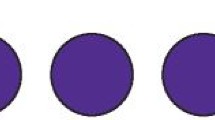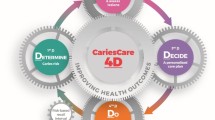Abstract
Objectives To define an expert Delphi consensus on when to intervene in the caries process and existing carious lesions.
Methods Non-systematic literature synthesis, expert Delphi consensus process and expert panel conference.
Results Lesion activity, cavitation and cleansability determine intervention thresholds. Inactive lesions do not require treatment (in some cases, restorations may be placed for form, function, aesthetics); active lesions do. Non-cavitated carious lesions should be managed non- or micro-invasively, as should most cavitated lesions which are cleansable. Cavitated lesions which are not cleansable usually require minimally invasive management. In specific circumstances, mixed interventions may be applicable. Occlusally, cavitated lesions confined to enamel/non-cavitated lesions extending radiographically into deep dentine may be exceptions. Proximally, cavitation is hard to assess tactile-visually. Most lesions extending radiographically into the middle/inner third of dentine are assumed to be cavitated. Those restricted to the enamel are not cavitated. For lesions extending radiographically into the outer third of dentine, cavitation is unlikely. These lesions should be managed as if they were non-cavitated unless otherwise indicated. Individual decisions should consider factors modifying these thresholds.
Conclusions Comprehensive diagnosis is the basis for systematic decision-making on when to intervene in the caries process and existing lesions.
Key points
-
Provides much needed guidance for the primary care practitioner to help in their management of dental caries.
-
Considers the quality of the evidence available to provide pragmatic guidelines for caries management interventions.
-
Comprehensive diagnosis is the basis for systematic decision-making on when to intervene in the caries process and existing lesions
This is a preview of subscription content, access via your institution
Access options
Subscribe to this journal
Receive 24 print issues and online access
$259.00 per year
only $10.79 per issue
Buy this article
- Purchase on Springer Link
- Instant access to full article PDF
Prices may be subject to local taxes which are calculated during checkout




Similar content being viewed by others
References
Sackett D L, Rosenberg W M C, Gray J A M, Haynes R B, Richardson W S. Evidence based medicine: what it is and what it isn't. BMJ 1996; 312: 71-72.
Frencken J E, Innes N P, Schwendicke F. Managing Carious Lesions: Why Do We Need Consensus on Terminology and Clinical Recommendations on Carious Tissue Removal? Adv Dent Res 2016; 28: 46-48.
Innes N P, Frencken J E, Schwendicke F. Don't Know, Can't Do, Won't Change: Barriers to Moving Knowledge to Action in Managing the Carious Lesion. J Dent Res 2016; 95: 485-486.
Frencken J E, Peters M C, Manton D J, Leal S C, Gordan V V, Eden E. Minimal intervention dentistry for managing dental caries - a review: report of a FDI task group. Int Dent J 2012; 62: 223-243.
Schwendicke F, Frencken J E, Bjorndal L et al. Managing Carious Lesions: Consensus Recommendations on Carious Tissue Removal. Adv Dent Res 2016; 28: 58-67.
Junger S, Payne S A, Brine J, Radbruch L, Brearley S G. Guidance on Conducting and Reporting Delphi Studies (CREDES) in palliative care: Recommendations based on a methodological systematic review. Palliative Medicine 2017: 31: 684-706.
GBD 2017 Disease and Injury Incidence and Prevalence Collaborators. Global, regional, and national incidence, prevalence, and years lived with disability for 354 diseases and injuries for 195 countries and territories, 1990-2017: a systematic analysis for the Global Burden of Disease Study 2017. Lancet 2019; 393: e44.
Keyes PH. The infectious and transmissible nature of experimental dental caries. Findings and implications. Arch Oral Biol 1960; 1: 304-320.
Keyes P H, Fitzgerald R J. Dental caries in the Syrian hamster. IX. Arch Oral Biol 1962; 7: 267-277.
Marsh PD. Dental plaque as a biofilm and a microbial community - implications for health and disease. BMC Oral Health 2006; 6: S14.
Marsh PD. In Sickness and in Health - What Does the Oral Microbiome Mean to Us? An Ecological Perspective. Adv Dent Res 2018; 29: 60-65.
Fisher-Owens S A, Gansky S A, Platt L J et al. Influences on children's oral health: a conceptual model. Pediatrics 2007; 120: e510-520.
Gomez A, Espinoza J L, Harkins D M et al. Host Genetic Control of the Oral Microbiome in Health and Disease. Cell Host Microbe 2017; 22: 269-278.
Takahashi N, Nyvad B. The role of bacteria in the caries process: ecological perspectives. J Dent Res 2011; 90: 294-303.
Dawes C. What is the critical pH and why does a tooth dissolve in acid? J Can Dent Assoc 2003; 69: 722-724.
Vieira A R, Gibson C W, Deeley K, Xue H, Li Y. Weaker dental enamel explains dental decay. PloS One 2015; 10: e0124236.
Weber M, Bogstad Sovik J, Mulic A et al. Redefining the Phenotype of Dental Caries. Caries Res 2018; 52: 263-271.
Valdebenito B, Tullume-Vergara P O, Gonzalez W, Kreth J, Giacaman R A. In silico analysis of the competition between Streptococcus sanguinis and Streptococcus mutans in the dental biofilm. Mol Oral Microbiol 2018; 33: 168-180.
Takahashi N, Nyvad B. Ecological Hypothesis of Dentin and Root Caries. Caries Res 2016; 50: 422-431.
Banerjee A. 'Minimum intervention' - MI inspiring future oral healthcare? Br Dent J 2017; 223: 133-135.
Schwendicke F, Gostemeyer G. Understanding dentists' management of deep carious lesions in permanent teeth: a systematic review and meta-analysis. Implementation Sci 2016: IS 11: 142.
Innes N, Schwendicke F. Restorative Thresholds for Carious Lesions: Systematic Review and Meta-analysis. J Dent Res 2017; 96: 501-508.
Albino J, Tiwari T. Preventing Childhood Caries: A Review of Recent Behavioral Research. J Dent Res 2016; 95: 35-42.
Domejean S, Banerjee A, Featherstone J D B. Caries risk/susceptibility assessment: its value in minimum intervention oral healthcare. Br Dent J 2017; 223: 191-197.
Ismail A. Diagnostic levels in dental public health planning. Caries Res 2004; 38: 199-203.
Kassebaum N J, Bernabe E, Dahiya M, Bhandari B, Murray C J, Marcenes W. Global burden of untreated caries: a systematic review and metaregression. J Dent Res 2015; 94: 650-658.
Raedel M, Hartmann A, Bohm S et al. Four-year outcomes of restored posterior tooth surfacesa massive data analysis. Clin Oral Invest 2017; 21: 2819-2825.
Burke F J, Lucarotti P S, Holder R L. Outcome of direct restorations placed within the general dental services in England and Wales (Part 2): variation by patients' characteristics. J Dent 2005; 33: 817-826.
Schwendicke F, Gostemeyer G, Blunck U, Paris S, Hsu L Y, Tu Y K. Directly Placed Restorative Materials: Review and Network Meta-analysis. J Dent Res 2016; 95: 613-622.
Elderton RJ. Clinical studies concerning re-restoration of teeth. Adv Dent Res 1990; 4: 4-9.
Brantley C, Bader J, Shugars D, Nesbit S. Does the cycle of rerestoration lead to larger restorations? J Am Dent Assoc 1995; 126: 1407-1413.
Tyas M J, Anusavice K J, Frencken J E, Mount G J. Minimal intervention dentistry - a review. FDI Commission Project 1-97. Int Dent J 2000; 50: 1-12.
Moynihan P J, Kelly S A M. Effect on Caries of Restricting Sugars Intake: Systematic Review to Inform WHO Guidelines. J Dent Res 2014; 93: 8-18.
Slayton R L, Urquhart O, Araujo MW B et al. Evidence-based clinical practice guideline on nonrestorative treatments for carious lesions: A report from the American Dental Association. J Am Dent Assoc 2018; 149: 837-849.
Marinho V C, Worthington H V, Walsh T, Clarkson J E. Fluoride varnishes for preventing dental caries in children and adolescents. The Cochrane database of systematic reviews 2013;7: Cd002279.
Walsh T, Worthington H V, Glenny A M et al. Fluoride toothpastes of different concentrations for preventing dental caries in children and adolescents. The Cochrane database of systematic reviews 2010: Cd007868.
Wolff M S, Schenkel A B. The Anticaries Efficacy of a 1.5% Arginine and Fluoride Toothpaste. Adv Dent Res 2018; 29: 93-97.
Wierichs R J, Meyer-Lueckel H. Systematic Review on Noninvasive Treatment of Root Caries Lesions. J Dent Res 2015; 94: 261-271.
Baysan A, Lynch E, Ellwood R et al. Reversal of primary root caries using dentifrices containing 5,000 and 1,100 ppm fluoride. Caries Res 2001; 35: 41-46.
Ekstrand K, Martignon S, Holm-Pedersen P. Development and evaluation of two root caries controlling programmes for home-based frail people older than 75 years. Gerodontology 2008; 25: 67-75.
Ekstrand K R, Poulsen J E, Hede B et al. A randomized clinical trial of the anti-caries efficacy of 5,000 compared to 1,450 ppm fluoridated toothpaste on root caries lesions in elderly disabled nursing home residents. Caries Res 2013; 47: 391-398.
Marinho V C, Chong L Y, Worthington H V, Walsh T. Fluoride mouthrinses for preventing dental caries in children and adolescents. Cochrane Database Syst Rev 2016; 7: Cd002284.
Gao S S, Zhang S, Mei M L, Lo E C, Chu C H. Caries remineralisation and arresting effect in children by professionally applied fluoride treatment - a systematic review. BMC Oral Health 2016; 16: 12.
Fung M H T, Duangthip D, Wong M C M, Lo E C M, Chu C H. Randomized Clinical Trial of 12% and 38% Silver Diamine Fluoride Treatment. J Dent Res 2018; 97: 171-178.
Alkilzy M, Santamaria R M, Schmoeckel J, Splieth C H. Treatment of Carious Lesions Using Self-Assembling Peptides. Adv Dent Res 2018; 29: 42-47.
Fontana M. Enhancing Fluoride: Clinical Human Studies of Alternatives or Boosters for Caries Management. Caries Res 2016; 50 Suppl 1: 22-37.
Alkilzy M, Tarabaih A, Santamaria R M, Splieth C H. Self-assembling Peptide P11-4 and Fluoride for Regenerating Enamel. J Dent Res 2018; 97: 148-154.
Krois J, Gostemeyer G, Reda S, Schwendicke F. Sealing or infiltrating proximal carious lesions. J Dent 2018; 74: 15-22.
Schwendicke F, Jager A M, Paris S, Hsu L Y, Tu Y K. Treating pit-and-fissure caries: a systematic review and network meta-analysis. J Dent Res 2015; 94: 522-533.
Griffin S O, Oong E, Kohn W et al. The Effectiveness of Sealants in Managing Caries Lesions. J Dent Res 2008; 87: 169-174.
Fontana M, Platt J A, Eckert G J et al. Monitoring of sound and carious surfaces under sealants over 44 months. J Dent Res 2014; 93: 1070-1075.
Hesse D, Bonifacio C C, Mendes F M et al. Sealing versus partial caries removal in primary molars: a randomized clinical trial. BMC Oral Health 2014; 14: 58.
Bakhshandeh A, Qvist V, Ekstrand K. Sealing occlusal caries lesions in adults referred for restorative treatment: 2-3 years of follow-up. Clin Oral Invest 2012; 16: 521-529.
Mickenautsch S, Yengopal V. Validity of sealant retention as surrogate for caries prevention - a systematic review. PloS One 2013; 8: e77103.
Paris S, Hopfenmuller W, Meyer-Lueckel H. Resin Infiltration of Caries Lesions. J Dent Res 2010; 89: 823-826.
Gruythuysen R. Non-Restorative Cavity Treatment. Managing rather than masking caries activity. Nederlands tijdschrift voor tandheelkunde 2010; 117: 173-180.
Mijan M, de Amorim R G, Leal S C et al. The 3.5-year survival rates of primary molars treated according to three treatment protocols: a controlled clinical trial. Clin Oral Invest 2014; 18: 1061-1069.
Santamaria R M, Innes N P T, Machiulskiene V et al. Alternative Caries Management Options for Primary Molars: 2.5-Year Outcomes of a Randomised Clinical Trial. Caries Res 2017; 51: 605-614.
Hansen N V, Nyvad B. Non-operative control of cavitated approximal caries lesions in primary molars: a prospective evaluation of cases. J Oral Rehab 2017; 44: 537-544.
Lo E C, Schwarz E, Wong M C. Arresting dentine caries in Chinese preschool children. Int J Paed Dent 1998; 8: 253-260.
Hickel R, Kaaden C, Paschos E et al. Longevity of occlusally-stressed restorations in posterior primary teeth. Am J Dent 2005; 18: 198-211.
Innes N P, Evans D J, Stirrups D R. Sealing caries in primary molars: randomized control trial, 5-year results. J Dent Res 2011; 90: 1405-1410.
Nyvad B, Machiulskiene V, Baelum V. Reliability of a new caries diagnostic system differentiating between active and inactive caries lesions. Caries Res 1999; 33: 252-260.
Braga M, Mendes F, Martignon S, Ricketts D, Ekstrand K. In vitro comparison of Nyvad's system and ICDAS-II with lesion activity assessment for evaluation of severity and activity of occlusal caries lesions in primary teeth. Caries Res 2009; 43: 405-412.
Braga M M, Martignon S, Ekstrand K R, Ricketts D N, Imparato J C, Mendes F M. Parameters associated with active caries lesions assessed by two different visual scoring systems on occlusal surfaces of primary molars - a multilevel approach. Comm Dent Oral Epidemiol 2010; 38: 549-558.
Nyvad B, Fejerskov O. Assessing the stage of caries lesion activity on the basis of clinical and microbiological examination. Comm Dent Oral Epidemiol 1997; 25: 69-75.
Ferreira Zandona A, Santiago E, Eckert G J et al. The natural history of dental caries lesions: a 4-year observational study. J Dent Res 2012; 91: 841-846.
Wenzel A. Radiographic display of carious lesions and cavitation in approximal surfaces: Advantages and drawbacks of conventional and advanced modalities. Acta Odontol Scand 2014; 72: 251-264.
Tassery H, Levallois B, Terrer E et al. Use of new minimum intervention dentistry technologies in caries management. Aust Dent J 2013; 58: 40-59.
Broadbent J M, Foster Page L A, Thomson W M, Poulton R. Permanent dentition caries through the first half of life. Br Dent J 2013; 215: E12. https://doi.org/10.1038/sj.bdj.2013.991.
Mejare I, Axelsson S, Dahlen G et al. Caries risk assessment. A systematic review. Acta Odontol Scand 2013; 72: 81-91.
Lopez R, Smith P C, Gostemeyer G, Schwendicke F. Ageing, dental caries and periodontal diseases. J Clin Perio 2017; 44: S145-S152.
Bratthall D, Hansel Petersson G. Cariograma multifactorial risk assessment model for a multifactorial disease. Comm Dent Oral Epidemiol 2005; 33: 256-264.
Hayes M, Da Mata C, McKenna G, Burke F M, Allen P F. Evaluation of the Cariogram for root caries prediction. J Dent 2017; 62: 25-30.
Domejean S, White J M, Featherstone J D. Validation of the CDA CAMBRA caries risk assessment - a six-year retrospective study. J Calif Dent Assoc 2011; 39: 709-715.
Innes N P, Manton D J. Minimum intervention children's dentistry - the starting point for a lifetime of oral health. Br Dent J 2017; 223: 205-213.
Leal S C. Minimal intervention dentistry in the management of the paediatric patient. Br Dent J 2014; 216: 623-627.
Manhart J, Chen H, Hamm G, Hickel R. Buonocore Memorial Lecture. Review of the clinical survival of direct and indirect restorations in posterior teeth of the permanent dentition. Oper Dent 2004; 29: 481-508.
Ribeiro A A, Purger F, Rodrigues J A et al. Influence of contact points on the performance of caries detection methods in approximal surfaces of primary molars: an in vivo study. Caries Res 2015; 49: 99-108.
Smail-Faugeron V, Glenny A M, Courson F, Durieux P, Muller-Bolla M, Fron Chabouis H. Pulp treatment for extensive decay in primary teeth. Cochrane Database Syst Rev 2018; 5: Cd003220.
Ethical approval
This article does not contain any studies with human participants or animals performed by any of the authors.
Informed consent
For this type of study, formal consent is not required.
Author information
Authors and Affiliations
Corresponding author
Ethics declarations
The corresponding author formally requested a declaration of possible conflicts of interest from each of the consensus panel members. No relevant conflicts of interest at the organisational and individual levels related to this consensus document were identified.
Funding
The conference was kindly sponsored by DMG (Hamburg, Germany). This included travel, accommodation and conference costs for panel members. The sponsor had no role in design or conduct of the conference or the content of this manuscript and were not present during the conference. No honoraria were given to any of the panel members.
Rights and permissions
About this article
Cite this article
Banerjee, A., Splieth, C., Breschi, L. et al. When to intervene in the caries process? A Delphi consensus statement. Br Dent J 229, 474–482 (2020). https://doi.org/10.1038/s41415-020-2220-4
Published:
Issue Date:
DOI: https://doi.org/10.1038/s41415-020-2220-4
This article is cited by
-
In vitro remineralization of adjacent interproximal enamel carious lesions in primary molars using a bioactive bulk-fill composite
BMC Oral Health (2024)
-
Increasing awareness of risk literacy
British Dental Journal (2023)
-
Top tips for minimally invasive dentistry in primary care
British Dental Journal (2023)
-
Comparison of calcium-based technologies to remineralise enamel subsurface lesions using microradiography and microhardness
Scientific Reports (2022)
-
Fissure sealing and caries development in Norwegian children
European Archives of Paediatric Dentistry (2022)



